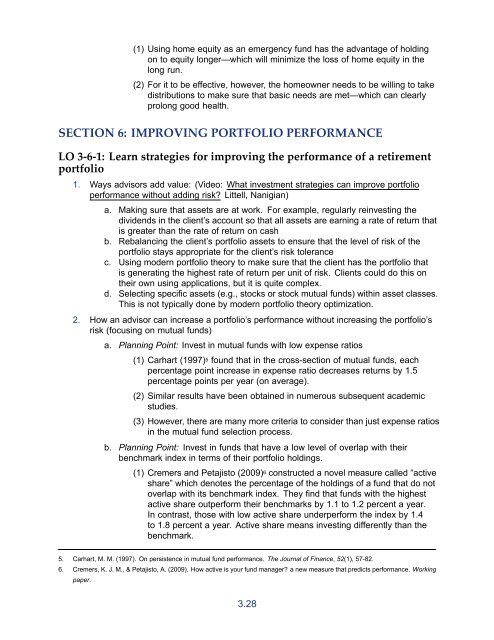section 1 - The American College Online Learning Center
section 1 - The American College Online Learning Center
section 1 - The American College Online Learning Center
You also want an ePaper? Increase the reach of your titles
YUMPU automatically turns print PDFs into web optimized ePapers that Google loves.
(1) Using home equity as an emergency fund has the advantage of holdingon to equity longer—which will minimize the loss of home equity in thelong run.(2) For it to be effective, however, the homeowner needs to be willing to takedistributions to make sure that basic needs are met—which can clearlyprolong good health.SECTION 6: IMPROVING PORTFOLIO PERFORMANCELO 3-6-1: Learn strategies for improving the performance of a retirementportfolio1. Ways advisors add value: (Video: What investment strategies can improve portfolioperformance without adding risk? Littell, Nanigian)a. Making sure that assets are at work. For example, regularly reinvesting thedividends in the client’s account so that all assets are earning a rate of return thatis greater than the rate of return on cashb. Rebalancing the client’s portfolio assets to ensure that the level of risk of theportfolio stays appropriate for the client’s risk tolerancec. Using modern portfolio theory to make sure that the client has the portfolio thatis generating the highest rate of return per unit of risk. Clients could do this ontheir own using applications, but it is quite complex.d. Selecting specific assets (e.g., stocks or stock mutual funds) within asset classes.This is not typically done by modern portfolio theory optimization.2. How an advisor can increase a portfolio’s performance without increasing the portfolio’srisk (focusing on mutual funds)a. Planning Point: Invest in mutual funds with low expense ratios(1) Carhart (1997) 5 found that in the cross-<strong>section</strong> of mutual funds, eachpercentage point increase in expense ratio decreases returns by 1.5percentage points per year (on average).(2) Similar results have been obtained in numerous subsequent academicstudies.(3) However, there are many more criteria to consider than just expense ratiosin the mutual fund selection process.b. Planning Point: Invest in funds that have a low level of overlap with theirbenchmark index in terms of their portfolio holdings.(1) Cremers and Petajisto (2009) 6 constructed a novel measure called “activeshare” which denotes the percentage of the holdings of a fund that do notoverlap with its benchmark index. <strong>The</strong>y find that funds with the highestactive share outperform their benchmarks by 1.1 to 1.2 percent a year.In contrast, those with low active share underperform the index by 1.4to 1.8 percent a year. Active share means investing differently than thebenchmark.5. Carhart, M. M. (1997). On persistence in mutual fund performance. <strong>The</strong> Journal of Finance, 52(1), 57-82.6. Cremers, K. J. M., & Petajisto, A. (2009). How active is your fund manager? a new measure that predicts performance. Workingpaper.3.28
















